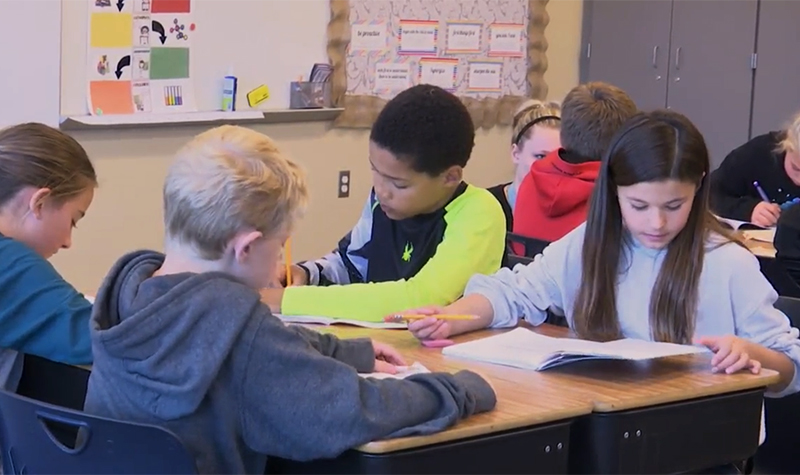Teaching the teachers: UND faculty train K-12 staffs on students’ mental health
Faculty share with regional teachers best practices for addressing mental health challenges among students

Led by faculty at the University of North Dakota, a federal grant for the Mountain Plains Mental Health Technology Transfer Center (MHTTC) in partnership with the Western Interstate Commission for Higher Education is delivering mental health training to schools across the state.

Sarah Nielsen, associate professor of occupational therapy in the UND School of Medicine & Health Sciences, has been leading the Promoting Positive Mental Health in Rural Schools initiative since last fall, after Chester Fritz Distinguished Professor Thomasine Heitkamp and her MHTTC team wrote a proposal for additional funding to assist the MHTTC. The purpose of the additional funding is to help schools address mental well-being and behavioral regulation in children and adolescents.
The funding stems from a five-year, $3.8 million grant delivered to the MHTTC through the Substance Abuse and Mental Health Services Administration (SAMHSA), part of the U.S. Department of Health and Human Services.
The Mountain Plains MHTTC is one of 12 such centers under SAMHSA with a primary focus of providing training, resources and technical assistance to mental health service providers. The Mountain Plains team includes faculty and staff from UND (led by Heitkamp) and staff from the Western Interstate Commission for Higher Education.
The additional funding for half a million dollars granted in 2018 and 2019 has now reached 14 schools in North Dakota and South Dakota — two of the six states comprising Region 8 of the federal department — in the form of webinars, on-site training and distribution of resources for faculty and staff working in classrooms. Notably, UND faculty, including Heitkamp, Nielsen and UND Assistant Professor of Rural Health Shawnda Schroeder have written a publication for the project titled “Promoting Positive Mental Health in Rural Schools” that provides best practices to school personnel and is being shared across the country.

Evidence-based response
Heitkamp, professor of nursing in the College of Nursing & Professional Disciplines, said greater attention at the federal level came to youth in schools in response to the increasing frequency of school shootings.

Among other issues, “the U.S. government was worried about the emotional well-being of children in schools and reasoned that if there were stronger supports to better assist school personnel to address mental health needs of students, that youth and educators would both benefit,” Heitkamp said.
“The focus is to apply evidence-based research in schools to better address the mental health needs of students.”
UND’s lead on delivering guidance and best practices to schools has gained the attention of local media, as Prairie Rose Elementary in Dickinson, N.D., showed when its staff took part in training sessions led by Nielsen.
Before coming to UND in 2011, Nielsen spent 11 years working at Trinity Health in Minot, N.D., in its child/adolescent partial hospitalization program. She spent time with students removed from their schools due to persistent behavioral issues and emotional distress, teaching them skills that would enable them to return to their “primary activity:” their education.
At UND, she teaches future professionals along similar lines in the Occupational Therapy and other departments.
Heitkamp was aware of the good work Nielsen was doing on campus, as well as Nielsen’s experience with young students struggling to regulate their behaviors. There was also the opportunity to work in an interdisciplinary manner, which Heitkamp emphasized expands access to a wide range of professionals and their expertise.
As a result, Heitkamp recruited Nielsen to lead this project under the school-based MHTTC.

Creating communities of practice
The program gave Nielsen the chance to make an impact in her hometown of Crosby, N.D., at Divide County Elementary. Tanja Brown serves as the principal of the 215-student school and jumped at the chance to be among the pilot schools for Nielsen’s efforts.
Training sessions occurring once a month from January to May took place through a combination of Zoom video conferences and an on-site visit from Nielsen.
“My role with the schools was to facilitate communities of practice,” Nielsen said. These communities of practice, made up of a diverse group of school staffers, would attend the initial training sessions and develop strategies to integrate positive mental health practices into the everyday activities of the classroom.
Brown provided some examples of “embedded strategies,” such as creating a lesson in art class where students brainstormed positive phrases about themselves and turned them into banners for the hallways. In English class, for an assignment in journal-writing, a teacher might have students write about how they’re feeling and why.
“It’s pulling emotional learning and self-awareness skills into activities we’re already doing,” Brown said. “The training sessions had us thinking about ways to make the vocabulary of mental health part of the classroom experience. We want to break down the barriers around talking about it.”
On-site visits to cohort schools would be varied, as they were specific to the needs of the school, Nielsen said. At Divide County Elementary, Nielsen provided training on how to develop a trauma-sensitive school – how to work with students who have experienced trauma and meet their needs.
“When kids go to school, they don’t leave their mental health issues behind,” Nielsen said. “But the role of the educator is to teach them and help them reach their best capacity, so we teach educators how to modify the environment and change their responses to students.”

Mental health literacy
Nielsen also worked with educators on social emotional learning: teaching children how to regulate their emotions.
“We know about 50% of classroom teachers do not feel at all well-equipped [to teach emotional regulation],” Nielsen explained. “A teacher is not a counselor, but a teacher can see when a child is feeling overwhelmed or distressed.”
While most teachers are very in tune with children and motivated to work with them, emotional learning and development is something most people learn secondhand, Nielsen said.
What Nielsen and the MHTTC offer through their program are strategies that are supported by evidence. A key aspect of the MHTTC’s initiative is providing a wealth of literature and resources via the web. Training videos and PowerPoints from Nielsen’s sessions remain available to the communities of practice established at participating schools.
“A basic part of our training is giving teachers mental health literacy,” Nielsen said. “What does it mean if a student has attention deficit hyperactivity disorder or depression or anxiety? What does that look like for students when they come to their academic day?”
With additional awareness developed through training with communities of practice, teachers will be able to not only recognize unusual or disparate behaviors, but also understand what those behaviors might indicate.

‘Well worth the time’
As Brown discussed the value of the MHTTC programming in an interview with UND Today, she characterized the unique circumstances of rural life. Even in a community like Crosby that’s fortunate to have two counselors and a guidance counselor available to the school district, access to resources is limited.
“We are fortunate to have the services we do in our community, but sometimes we need more or a different type of support that we don’t have,” Brown said. “This program bolsters our staff, who are on the frontline of student well-being. Being educators, not specifically trained in mental health, this was an eye-opening experience. We now have knowledge to help these children, as well as ourselves.”
Brown says the windfall of online resources and guidance couldn’t have come at a better time. Though the student population in Crosby is relatively small, the makeup is shifting and more varied than at any point in Crosby’s history. The town is positioned at the northern tip of North Dakota’s oil country, so children come and go regularly.
“When I was growing up here, having one new family arrive during the school year used to be a big deal,” Brown explained. “Today, in contrast, we have such a different makeup of the students we serve, who may be bringing trauma and other mental health issues with them.
This training is “well worth the time and discussions,” Brown continued. “Most of our staff would say that, too. They value having the opportunity to talk about experiences with one another and what they can now use for intervention.”



